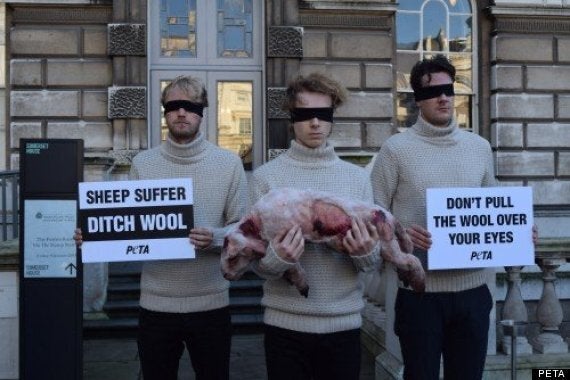I've been a vegan for five years, and people frequently ask me to explain what's wrong with wearing wool.
Last week, I was at Somerset House, where the finals of Woolmark's menswear design competition took place as part of Men's Fashion Week. I had a bloodied "lamb" in tow to show people what's wrong with wearing wool. Everything about the production of wool is objectionable, especially the shearing process which often leaves sheep battered and bloodied, the widespread Australian practice of mulesing - a barbaric procedure during which huge swaths of flesh and skin are carved from lambs' backsides in a crude attempt to prevent a maggot infestation - and the live exportation trade, in which tens of thousands of sensitive sheep suffer on arduous journeys from Australia to the Middle East and North Africa, where they're violently slaughtered for their flesh.
Most people don't know that Woolmark is a trademark owned by Australian Wool Innovation (AWI), a company whose main objective is to promote the use of wool within the fashion industry. Woolmark uses marketing ploys and gimmicks to encourage the use of wool, including the "design competition" hosted at Somerset House last week.

Last year, PETA US, whose motto reads in part that "animals are not ours to wear", released its international exposé of the wool industry in the US and Australia - the source of 90% of the world's merino wool. The harrowing footage shows workers stamping and standing on sheep's heads, violently punching them in the face, and hitting them on the head with electric clippers and hammers. The investigators revealed that some sheep even died from the abuse, including one whose neck was twisted so violently that it broke. These are not isolated incidents. The investigators worked undercover at more than 30 farms and wool sheds over a period of several months. Taken together, these shearing crews likely shear millions of sheep every year.
It's easy to see why such abuse is commonplace. Most shearers are paid by volume, not by the hour, which means that they are motivated to work as quickly as they can, with little regard for the sheep's welfare. Sheep sustain gaping wounds, and workers crudely sew up the worst of them without giving them any pain relief whatsoever. PETA US investigators never saw anyone reprimanded for abusive treatment of sheep nor did they witness any veterinary care administered to the animals. Instead, injured sheep were shot dead right in front of their companions, and one was even butchered and left in full view of other terrified sheep.
Life for British sheep is no easier. In the UK, wool producers subject lambs to painful mutilations such as tail amputation and castration - all without the use of anaesthetics. It is considered normal in the wool industry for at least 4% of young lambs to die every spring, primarily of malnutrition. Lameness caused by untreated scald and foot rot (painful bacterial infections) is found in approximately 18% of British flocks, and many ewes are killed just to prevent them from passing an infection on to other sheep.

Many consumers and retailers - including Marks & Spencer, ASOS, UNIQLO, Topshop and H&M - avoid wool that comes from mulesed sheep. The pain from the wounds caused by mulesing is so intense that it often causes lambs to walk sideways like crabs. Many of these wounds can take weeks to heal - and some never do. Boycotting wool from mulesed sheep is a good first step, but buying any wool means potentially supporting the kind of abuse and suffering exposed by the PETA US investigation.
The only way to be sure we're not buying into cruelty is to leave wool - and all other clothing made from animals - out of our wardrobes. With so many humane, warm and stylish fabrics, including rayon, cotton, ramie, woven metal, soya silk, acrylic, nylon and microfibre, there really can be no excuse for supporting the violent wool industry. To find out more about this issue, visit PETA's website.